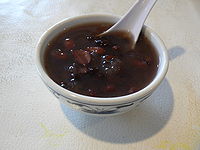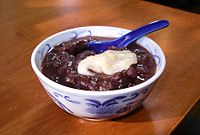- Red bean soup
-
Red bean soup 
A bowl of red bean soup Chinese name Traditional Chinese 1. 紅豆粥
2. 紅豆湯
3. 紅豆沙Simplified Chinese 1. 红豆粥
2. 红豆汤
3. 红豆沙Literal meaning 1. red bean congee
2. red bean soup
3. red bean sandTranscriptions Mandarin - Hanyu Pinyin 1. hóng dòu zhōu
2. hóng dòu tāng
3. hóng dòu shāCantonese (Yue) - Jyutping 1. hung4 dau6*2 zuk1
2. hung4 dau6*2 tong1
3. hung4 dau6*2 saa1Japanese name Kanji 汁粉 Hiragana しるこ Transcriptions - Revised Hepburn shiruko Korean name Hangul 팥죽 Hanja 팥粥 Transcriptions - Revised
Romanizationpatjuk - McCune-
Reischauerpat'chuk Red bean soup refers to a number of traditional Asian soups, all made with azuki beans.
Contents
China
In China, red bean soup (紅豆沙, pinyin: hǒng dòu shā) is a popular dish. The soup is commonly thinner than the Japanese oshiruko version. It is categorized as a tang shui糖水, (pinyin: táng shǔi) (literally translated as sugar water), or sweet soup. It is often served cold during the summer, and hot in the winter. Leftover red bean soup can also be frozen to make ice pops and is a popular dessert.
It is one of the main desserts offered after Cantonese cuisine meals in restaurants at night. When served, it is plain most of the time. The fancier restaurants may offer red bean soup with sago (西米, pinyin: xī mi). The two types of sugar used interchangeably are rock sugar and sliced sugar (片糖).
Japan
Shiruko (汁粉), or oshiruko (お汁粉) with the honorific "o" (お), is a traditional Japanese dessert.[1] It is a sweet porridge of azuki beans boiled and crushed, served in a bowl with mochi.[1][2] There are different styles of shiruko, such as shiruko with chestnuts, or with glutinous rice flour dumplings instead of mochi.
There are two types of shiruko based on difference of cooking way of azuki beans. Azuki beans could be turned into paste, crushed without keeping its original shape, or paste and roughly crushed beans are mixed.[2] There is a similar dish, zenzai (善哉、ぜんざい), which is made from condensed paste with heat and is less watery than shiruko, like making jam or marmalade. In Western Japan, Zenzai refers to a type of shiruko made from mixture of paste and crushed beans.[2] In Okinawa Prefecture, the term "zenzai" commonly refers to this bean soup served over shaved ice with "mochi". Other toppings, such as sweetened condensed milk, are occasionally added for flavor.
It is loved by many Japanese, especially during the winter.[2] The half-melted sticky mochi and the sweet, warm azuki bean porridge is thought by many to be an absolute delight. Shiruko is frequently served with a side dish of something sour or salty, such as umeboshi or shiokombu. This is because shiruko is so sweet that the taste cloys after a while, so the customer can refresh their palate with something sour or salty, such as shiokombu or umeboshi, or both.
In some regions including Kagawa Prefecture, shiruko is also used for zōni, the special soup for New Year celebration.
Korea
In Korean cuisine, red bean soup is called patjuk (팥죽), and is commonly eaten during the winter season. On Dongjinal, a Korean traditional holiday which falls on December 22, Korean people eat Donji patjuk, which contains saealsim (새알심) meaning bird egg, a ball made from glutinous rice flour, named such due to its resemblance to small bird's eggs, possibly quail eggs.
In old Korean tradition, patjuk is believed to have a mysterious power to drive evil spirits away.[3] According to Korean traditional folk beliefs, the color "red" is a symbolic color of positive energy which can defeat negative energy. Cooking and eating patjuk is a ritual to prevent bad luck, epidemic disease, and comes from evil spirits.[4] Before eating the dish, Korean people used to serve it their own house shrine, they scattered it all around the house like in the kitchen, storage house, gate, yard and so on.[5] These customs have been handed down through Chinese mythological stories. According to Hyungchosesigi, there was a man named Gong Gong. He had a bad son, and after he died he became a god of epidemic disease. Because of his cruel temper, a lot of people were killed by epidemics. Trying to find a solution to prevent infectious diseases, they recalled the fact that the son of Gong Gong hated "red bean soup" when he was alive. Thus, people made red bean soup and scattered it all around the house. And then the epidemics disappeared. Since then, patjuk has been the food that all spirits hate.
Eating patjuk is a ritual to wish for abundant harvests.[6] Ancient Korea was an agrarian society, and a rich harvest has always been a pivotal issue for them. Koreans eat Patjuk (red bean soup) on Donggi(winter solstice), when the days start becoming longer than nights. When they make Patjuk (red bean soup) they add small dumplings which were made of rice as the same number as their age.[7] By fully relaxing and eating nourishing health food, they wanted to have a preparation period before starting farming in the spring.
Patjuk embodies a custom of conserving food.[8] Koreans usually eat rice and side dishes. However, in the wintertime when Korean families had shortage of grains, patjuk became a complete meal itself. It could be made of simple ingredients. For example, red beans, water, small grains of rice and also it requires no need extra side dishes. Thus, when people prepare some events in winter, patjuk is an economical food for conserving grain.
Vietnam
Vietnamese cuisine also has a similar dish, called chè đậu đỏ.photo , it contains added coconut milk.
Australia
In major cities around Australia, it is sometimes served as complimentary dessert along with fruit, pudding and sometimes cake and biscuits at Cantonese restaurants.
See also
Notes
- ^ a b "shiruko Japanese". Uwajimaya. Archived from the original on 2007-11-21. http://web.archive.org/web/20071121182210/http://www.uwajimaya.com/glossary.asp?PrimaryName=shiruko+++++++++++++++++++++++++++++++++++++++++++&Alpha=S+++++++++. Retrieved 2007-11-13.
- ^ a b c d Otani, Hiromi (2004-03-05). "Shiruko: Sweet Bean Soup to Warm You Up in Cold Weather". Nipponia on Web Japan. http://web-japan.org/nipponia/nipponia28/en/appetit/index.html. Retrieved 2007-11-13.
- ^ Kim, p. 208
- ^ Jang, p. 301
- ^ Jeong, p. 278
- ^ Jang, p. 303
- ^ Hong, p. 555
- ^ Kang, p. 122
References
- Kim jong-dae. 12 months seasonal customs. Seoul: Sanha, 1996.
- Jang joo-geun. Seasonal customs in Korea. Seoul: Hyunseul, 1984.
- Jeong sung-mo. Seasonal customs in Korea. Seoul: Hakgojae, 2001.
- Korean national fork museum. Chosun seasonal custom. Seoul: Minsokwon, 2003.
- Hong seok-mo. Seasonal customs. Seoul: Bogosa, 2003.
- Kang moo-hak. Seasonal customs in Korea. Seoul: Zipmoondang, 1987.
External links
Categories:- Cantonese cuisine
- Chinese dessert
- Chinese soups
- Cold soups
- Korean cuisine
- Legume dishes
- Wagashi
Wikimedia Foundation. 2010.


